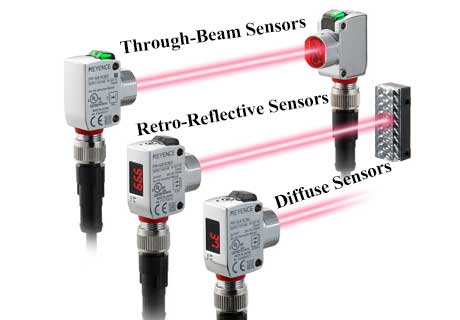What Are the Three Types of Photoelectric Sensors?
Key Takeaway
There are three principal types of photoelectric sensors used to detect objects: diffuse, retro-reflective, and through-beam. Diffuse sensors operate by sensing light reflected directly off an object, retro-reflective sensors utilize a reflector to return the light beam to the sensor, and through-beam sensors detect objects when they interrupt a light beam traveling from an emitter to a receiver
An Overview of Sensor Types
Understanding the different types of photoelectric sensors and their applications is crucial in the field of industrial automation. Each type is tailored to specific conditions and challenges, allowing for flexibility in solving a wide range of detection problems. Here’s a breakdown of the three main types you’ll encounter and how to choose the right one for your project.
Photoelectric sensors are distinguished primarily by how they detect the presence and distance of objects using light. These sensors are integral in automating processes, enhancing precision, and increasing safety across many industries. They broadly fall into three categories: diffuse, retro-reflective, and through-beam, each suited to different operational contexts.

Diffuse Sensors: Features and Uses
Diffuse sensors are perhaps the most versatile of the three types. They work by emitting a light beam from a single unit that reflects off the target back to the detector within the same housing. These sensors are ideal for short-range detection and are commonly used where object and sensor proximity is manageable. Their simplicity allows for easy setup and cost-effectiveness, making them a popular choice in applications such as material handling and packaging where precise alignment isn’t critical.
Retro-Reflective Sensors: Features and Uses
Retro-reflective sensors step up the range by using a reflector to bounce the light beam back from the emitter to the receiver, which are housed together. These are perfect when you need a longer detection range but still prefer the simplicity of installation akin to diffuse sensors. They are often used in industrial doors, conveyor systems, and where objects vary widely in color, shape, or surface finish, as the reflector standardizes the return signal regardless of object characteristics.
Through-Beam Sensors: Features and Uses
Through-beam sensors offer the highest range and are the most reliable for detecting presence, but they require alignment between two separate units: one emitter and one receiver. When an object breaks the beam, the receiver detects the interruption. This type is best for high-demand environments like assembly lines and automated warehouses where long-distance detection and high response rates are needed.
How to Select the Right Type
Choosing the right type of Omron photoelectric sensor or Other Brands requires understanding your specific application needs. Consider factors like the environment, distance to the target, the nature of the objects being detected, and how quickly the system must respond. Diffuse sensors are great for close, simple setups; retro-reflective sensors are suited for medium distances with simpler installation needs; through-beam sensors, while requiring more setup, provide the best performance for long distances and fast operations.
To make an informed choice, it’s essential to consider several key factors:
Environmental Considerations: The setting in which the sensor will operate can greatly influence the type of sensor you choose. Environments laden with dust, moisture, or extreme lighting conditions necessitate sensors that can cope with these challenges without performance degradation.
Distance to the Target: The required sensing range plays a pivotal role in selecting the appropriate sensor. For short-range applications, diffuse sensors are typically sufficient. These sensors detect objects directly in front of them without the need for a separate reflector, making them ideal for compact setups.
Nature of the Objects Being Detected: The physical characteristics of the objects, such as size, shape, and surface material, also affect the sensor choice. Diffuse sensors, for instance, might struggle with very shiny or transparent objects, whereas retro-reflective or through-beam sensors can provide more reliable detection under such conditions.
System Response Time: How quickly the sensor needs to detect objects and send the signal back to the control system is crucial, especially in high-speed automation scenarios. Through-beam sensors, although requiring more complex setup involving separate emitter and receiver units, excel in high-speed applications and over long distances, offering the quickest response times and highest detection reliability.
Each type of sensor—diffuse, retro-reflective, and through-beam—brings its strengths to different industrial applications, from simple assembly tasks to complex, high-speed operations. By carefully analyzing these factors in the context of your needs, you can select a photoelectric sensor that not only meets but enhances your system’s efficiency and accuracy.
Conclusion
In selecting the appropriate photoelectric sensor, balance is key. Evaluate the demands of your specific application to determine which sensor type will best meet your needs, enhancing both efficiency and reliability. Remember, the right sensor not only complements your operational needs but also reduces downtime and maintenance costs, ensuring your processes run smoothly and effectively. As you step further into the world of industrial automation, leveraging these insights will allow you to optimize your systems and drive innovation.
